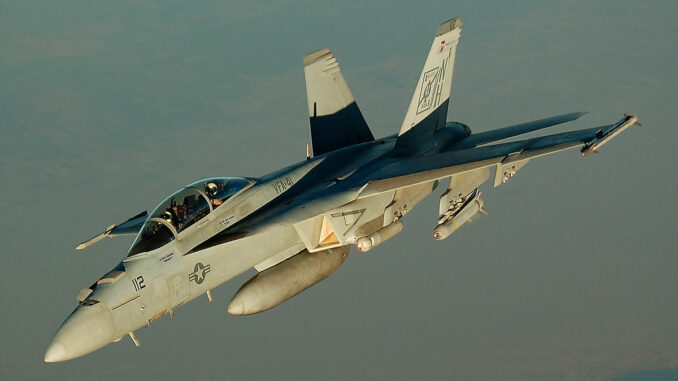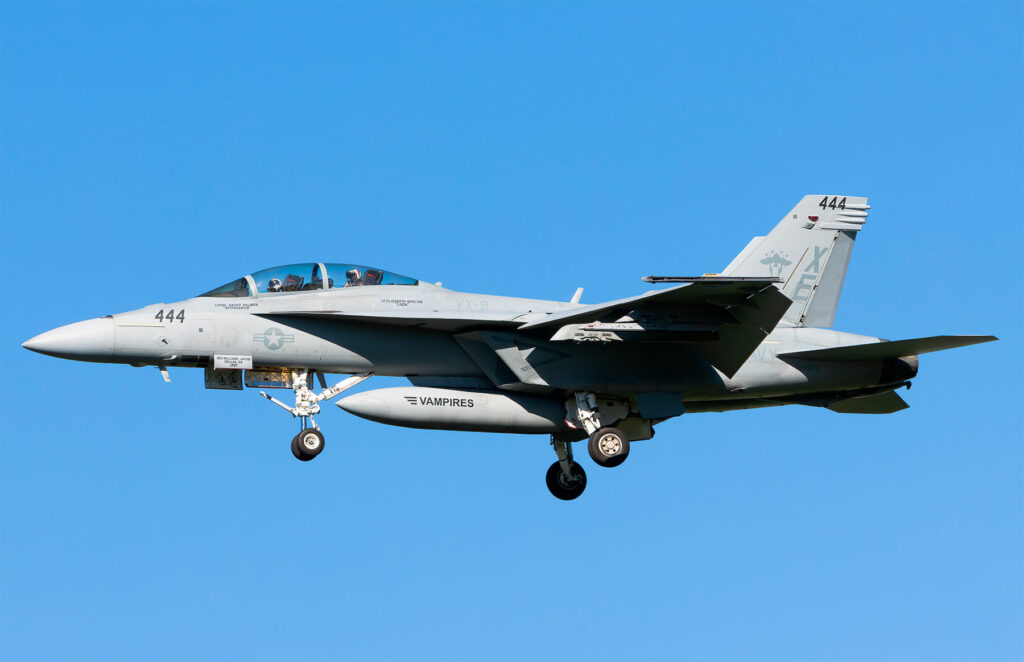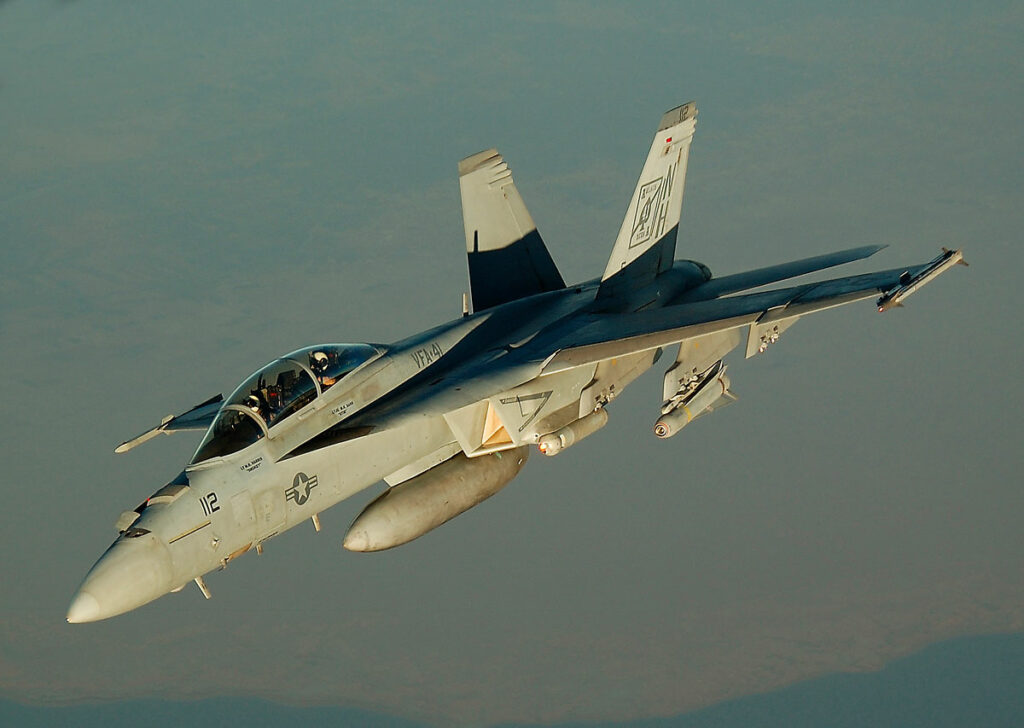
Boeing F/A-18 Super Hornet, American fighter jet. Complete analysis of its role in Libya, its strikes and advanced capabilities. Overview.
Background
The Boeing F/A-18 Super Hornet is an American fighter aircraft that serves in several air forces. Designed for multi-role operations, it meets a variety of objectives, from air superiority to targeted strikes. It is derived from the old F/A-18 Hornet, with improvements that increase its range and payload. Since first entering service in the late 1990s, it has been regularly deployed in various conflict zones.
In Libya, it took part in missions during operations led by various coalitions. The aim was to guarantee the security of intervention zones and protect friendly aircraft, while neutralizing opposing military equipment.
Key features of the F/A-18 Super Hornet
The Boeing F/A-18 Super Hornet is available in two main versions: F/A-18E (single-seater) and F/A-18F (two-seater). With a length of around 18.38 meters and a wingspan of 11.43 meters, it features a structure suitable for catapulting from aircraft carriers. Its engine enables it to reach a top speed close to Mach 1.8, i.e. nearly 1,915 km/h. Its operating ceiling often exceeds 15,000 meters.
The aircraft can carry a variety of munitions, including AIM-120 AMRAAM and AIM-9 Sidewinder air-to-air missiles, as well as GPS-guided bombs. Its payload capacity is around 8 tonnes. The average unit cost of a Super Hornet is around $60 million (about 55 million euros). This price includes basic equipment, but varies according to the configurations chosen.

Use in Libya: strategic foundations
During interventions in Libya, the F/A-18 Super Hornet served several purposes. The contingents who engaged it were looking for a multi-purpose aircraft, capable of :
- Intercept hostile aircraft
- Protect surveillance aircraft
- Carry out precision strikes against ground targets
The situation on the ground called for fast, precise aircraft, capable of reacting in a short space of time. The Libyan environment, with its dispersed anti-aircraft defenses, required an aircraft capable of avoiding ground threats and retaliating if necessary.
Key dates and missions in Libya
In 2011, an international coalition launched Operation Odyssey Dawn (March 19, 2011) to enforce a no-fly zone. Shortly afterwards, NATO took over with Operation Unified Protector (launched on March 31, 2011 and concluded on October 31, 2011). American F/A-18 Super Hornets, mainly deployed from aircraft carriers stationed in the Mediterranean, were engaged from the very first air strikes.
Notable missions
- March – April 2011: The Super Hornet participated in the establishment of the no-fly zone. Initial missions involved patrolling Libyan skies, intercepting any unauthorized aircraft and supporting coalition forces.
- April – June 2011: The aircraft was used to target Libyan radars and defense systems, particularly in the vicinity of strategic cities. The strikes were aimed at reducing ground-to-air fire capabilities.
- July – October 2011: Closer missions were carried out to destroy military infrastructure still in use. The Super Hornet provided regular air-to-ground support for security operations, until the official end of the NATO commitment.
Air defense and interception
One of the F/A-18 Super Hornet’s core tasks was to intercept suspicious or unidentified aircraft. Thanks to its active antenna radar (AESA), it can spot distant targets and react quickly. Long-range air-to-air missiles, such as the AIM-120 AMRAAM, give it an advantage in combat beyond direct sight.
In Libyan skies, this function took the form of daily air patrols to prevent any hostile incursions. When unauthorized aircraft appeared, the Super Hornet would position itself in their path to identify them and, if necessary, force them to leave the airspace under surveillance.
Protection of reconnaissance aircraft
Surveillance and intelligence operations were carried out to assess movements on the territory. Drones and reconnaissance aircraft, which are often slower, were vulnerable. The F/A-18 Super Hornet ensured their safety during critical missions.
Ground-to-air threats were an ever-present danger, and escort by multi-role fighters reduced the risks. The Super Hornet’s electronic countermeasures system was essential for jamming enemy detections. This coverage enabled the reconnaissance aircraft to achieve their objectives while limiting losses.
Air strikes on enemy positions
The F/A-18 Super Hornet was also used to neutralize anti-aircraft batteries. To do this, it was equipped with AGM-88 HARM missiles, suitable for destroying radars, or GPS-guided bombs for hitting specific points.
At the height of the operation (between April and June 2011), the Super Hornets carried out several sorties a day, often in coordination with other aircraft. These strikes helped to weaken Libyan ground-to-air defenses and gave the coalition forces relative freedom of action. However, some targeting errors did occur, leading to criticism of bomb accuracy in areas where enemy positions were sometimes poorly identified.
Operational data and logistics
The F/A-18 Super Hornet requires regular technical support. Its engines and navigation systems require constant checks. The aircraft is often catapulted from Nimitz-class or similar aircraft carriers. These embarked platforms played an important role in Operation Unified Protector, as they provided a departure point close to the Libyan coast.
On average, a Super Hornet consumes over 4,700 kg of fuel per flight hour, depending on flight configuration and mission type. Aerial refueling was therefore essential, particularly during extended patrols. From an operational point of view, the logistical complexity proved manageable thanks to the presence of dedicated refueling tankers (KC-135 or KC-130), but some delays and cancellations of sorties were reported when weather conditions complicated these procedures.

Tactical challenges and benefits
The Boeing F/A-18 Super Hornet was used to test its effectiveness in an asymmetric context. Positive feedback confirmed the aircraft’s versatility. It did, however, encounter some limitations, particularly in complex urban areas where target identification was more difficult. Some reports mention operations that had to be cancelled, as conditions did not guarantee safe targeting.
On a strategic level, the presence of this American fighter aircraft illustrated the ability of several nations to react quickly, despite the dispersion of certain Libyan defenses. The crews had to adapt their methods, refining the use of air-to-air and air-to-ground missiles. This ability to adapt is an asset for any modern fighter when faced with varied tactical configurations.
Operational review
Between March and October 2011, Super Hornets took part in air superiority missions, drone and intelligence protection, and surgical strikes. Several targets were successfully hit, weakening Libyan air defenses. On the other hand, some ground coordination errors and targeting inaccuracies occurred, revealing the difficulty of missions in urban areas.
At the end of Operation Unified Protector, the forces involved felt that the F/A-18 Super Hornet had fulfilled its role. Its range and payload capacity enabled it to effectively cover the objectives set. The lessons learned from this conflict were then used to improve collaboration procedures between fighters and UAVs, while reinforcing ground-based target identification tools.
Ultimately, this period demonstrated that the F/A-18 Super Hornet is a versatile American fighter, capable of both air superiority and precision strikes. Its missions in Libya proved its operational effectiveness, despite some coordination and identification failures that underline the importance of precise intelligence and careful planning.
War Wings Daily is an independant magazine.